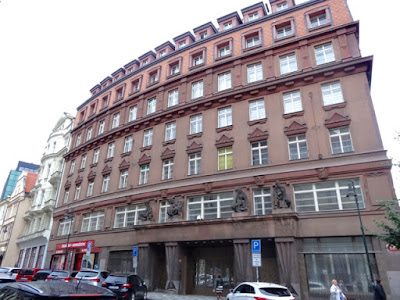目次 / Contents
1) ヴァーツラフ広場 周辺 / Around Wenceslas Square
2) ヴァーツラフ広場 / Wenceslas Square
1) ヴァーツラフ広場 周辺 / Around Wenceslas Square
ここは、"新市街 / ノヴェー・ムニュスト : New Town / Nové Město" と呼ばれる
地域で、カール4世 / Karl IV (1316 -1378 / ボヘミア王在位1346 - 1378) が、
1348年に作りました。
とても発展させた王様です。
新市街は、旧市街の2倍以上の広さがあります。
実は、前のセクションで扱ったダンシング・ハウスも新市街です (下記)。
Charles IV/ Karl IV (1316 -1378 / King of Bohemia region 1346 - 1378)
founded in 1348.
Charles IV understood 5 languages and made St. Vitus Cathedral (1344),
Charles Bridge (1357 -1402), and Charles University (1348).
He, the king, improved Prague so much.
The New Town is more than double the size of the Old Town.
Actually the Dancing House in previous section is in the New Town (below).
 |
| 古い建物群なのですが、入っているお店はイマドキのお店です。 There are old buildings, although the shops in the buildings are modern day. |
 |
| お店よりも建物の方が魅力的! The building is more attractive than the shops. |
 |
| ギャラリーのウィンドウ 残念ながら、このギャラリーはしまっていました。 In the Window of a Gallery Fortunately the gallery is closed. |
 |
| とてもお土産さんらしいウィンドウだったので、記念に撮影。 ウィンドウの文字を今見るとクラフト作品のお店で お土産やさんではないのかも? でもクラフトはお土産品でもあるから、どちらにしてもお土産やさんです。 This is a very souvenir shop window, so I photographed. I see the writings on the window now, I guess here might sell craft works, maybe it is not a souvenir shop? However, craft work is souvenir too, so whatever this is a souvenir shop. |
 |
| 古さと新しさがあわさったような建物 The building looks both old and new. |
 |
| アフガン・ハウンドが2匹も! 女性がアフガン・ハウンドを2匹も連れて都心を散歩しています。 彼女の長いスカートがアフガ ン・ハウンドの長い毛並みとあっていて、 この人、こういうタイプの犬、好きなのね〜と思わせます。 Two Afghan Hounds! A lady took two afghan hounds and walked in the city centre. Her long skirt suits the dog's long coats and let me think this person must like this type of dog. |
 |
ドアも素敵!
中が暗いとちょっとこわい?でも惹かれる?
Doors are
lovely, too! The inside is dark, so it is a little scary, but tempting?
|
 |
国立博物館が見えてきました。
改修工事のために少なくとも2018年まで閉鎖していることを このときは知りませんでした。
ほとんど下調べをしなかったチェコ旅行なので、
いろいろなことを知らないのでした。
公式サイト: ★ (英語)
The National Museum is in the distance.
I did not know the building was being repaired and closed at least until 2018. I did not prepare for this Czech trip, so I did not know many things.
Official website : ★
I thought this red crane and the red of buildings call to each other, so I photographed. |
 |
ヴァーツラフ広場
新市街で最も有名なランドマークが、ヴァーツラフ広場で、当初は、
"馬市場
/
Horse Market / Koňský
trh "
と呼ばれていました。
1848年に
、カレル・ハヴリーチェク・ボロフスキー (1821
-1856)
の提案によって、
ヴァーツラフ広場 / Saint
Wenceslas square / Svatováclavské náměstí
と名付けられました。
道の両側の建物のほとんどは19世紀後半から20世紀前半に建てられました。
現在では、広場は商業と観光の中心地です。
ヴァーツラフ広場は、広場といっても、南北に走る、この大通りのことです。
なので、ここはすでにヴァーツラフ広場。
Wenceslas Square
The
New Town's most famous landmark is Wenceslas
Square and
it
was initially called Horse Market / Koňský
trh".
It
was renamed Svatováclavské náměstí (English: Saint
Wenceslas square)
in
1848 following the proposal by Karel
Havlíček Borovský (1821 -1856).
The
buildings on the both sides were built
from
19th Century to the earlier 20th Century.
Now
the Square is the centre of commerce and tourism.
Even
though they say Wenceslas Square,
the
Square is this high street in a northwest–southeast direction.
Therefore
above photo is already Wenceslas Square.
|
2) ヴァーツラフ広場 / Wenceslas Square
 |
| 国立博物館本館正面 1891年、ヨーゼフ・シュルツ/ Josef Schulz (1840 - 1917) の設計で、 ネオ・ルネッサンス 様式。 ヴァーツラフ広場の南端にこの博物館があります。 北の端は旧市街との境界になります。
National
Museum Main Building Front
Josef
Schulz (1840 - 1917) designed in Neo-Renaissance style.
The South end of Wenceslas
Square is this Museum.
The North end meets the Old Town. ヨーゼフ・シュルツ/ Josef Schulz (1840 - 1917) 画像は下記より / This from below National Museum :★  後ろ / The Back  |
 |
|
写真は国立博物館本館にあるカール4世のネームプレート。
下はルドルフ2世 / Rudolf
II. (1552
-1612 / ボヘミア王在位1575
-1612) のもの。
Name Plate Charles IV / Karl IV founded the New Town as well as Wenceslas Square.
These
photographs are name plates, Charles
IV/ Karl IV : above,
Rudolf
II. (1552 -1612 / King of Bohemia region 1575 -1612)
: below.
 |
 |
聖ヴァーツラフ像
聖ヴァーツラフ (907 -935) は、チェコの守護聖人です。
像は、JosefVáclav Myslbek (1848 - 1922)によって
(1887年−)1924年に作られました。
お付きの彫像 (後ろ向き) は、写真左:聖アダルベルト/ St.
Adalbert
中:聖アグネス / St.
Agnes、 右 : 聖ルドミラ / St.
Ludmila
St. Wenceslas (907 -935) is the patron saint of Czech. In 1887-1924, the Monument was made by Josef Václav Myslbek (1848 - 1922) 
聖ヴァーツラフ
写真左:聖ルドミラ、中 : 聖プロコピウス / St. Procopius 、右:聖アダルベルト
St. Ludmila on the left, St. Agnes behind her,
St. Procopius on the right and St. Adalbert behind him.
説明はこのサイトから / The caption from here: ★
|
 |
たくさんの歴史上の出来事、反対運動や国の行事、
ソ連軍の戦車の侵入などなどがここで起きました。→★
Many historical events have occurred here, protest movements, National functions, Soviet army's tanks invaded and others.→★ |
 |
| この彫像たちは、いろいろなことを見てきたのですね。 These statues have seen many things, haven't they?   |
 |
| "プラハの春" (1968) において、この彫像達の前で 政治干渉及び軍事介入に抗議するヤン・パラフ(1948 - 1969) は、 焼身自殺をしました。 以前は聖ヴァーツラフ像の前と言われていましたが、 実際はここ(下の写真)です。 When Prague Spring (1968) was finished by a political and military intervention, a protester, Jan Palach (1948 - 1969) committed self-immolation in front of the statues. To begin with it was reported that he had set himself on fire in front of the St. Wenceslas Monument, in fact, he was here. (below) 
ヤン・パラフ記念碑、合掌
像のすぐ下にあります。
私が行ったときも、未だに生花が捧げられていて、 彼に対するチェコの人々の思いが伝わってきました。 [追記; 17th,Oct.2015. ヤン・ザジック/ Jan Zajíc (1950 - 1969) もヤン・パラフ同様、 ここで焼身自殺しています。この記念碑は彼のためでもあります]
The
Memorial to Jan Palach
"Añjali Mudrā" ; pay respect in Japanese
Here
is just at the statue's feet.
When I visited, even then, there were natural flowers in dedication and I felt Czech's feeling to him reached to me. [postscript ; 17th,Oct.2015.
JanZajíc (1950
- 1969) committed suicide here by self-immolation as Jan Palach.
So
this memorial is for him, too.] |


















